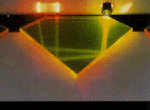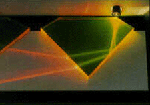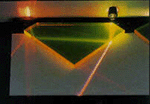A diamond in its natural state will allow light to pass through it. This is because the makeup of a diamond is generally transparent material. In the early times Diamond cutters learned to polish the flat surfaces of a diamond making the light reflect and refract into rainbows of light. Initially, there were several variations, but in 1919 diamond cutter Marcel Tolkowsky invented the 58-facet round brilliant cut pattern used by most diamond cutters today. This became known as the Round Brilliant Cut Diamond. A special subset of these diamonds with a particular “ideal” arrangement and angling of facets is known as an ‘ideal cut’ diamond full of brilliance and color. Today you can find many variations of the multi-faceted round diamond with diverse numbers of facets.
Amidon Jewelers carries the Phantom 105 Diamond™, a diamond that exceeds all the expectations. The 105 perfect facets are exquisitely cut and the Phantom 105 Diamond is nothing but breathtakingly extraordinary. New advancements in diamond cutting and polishing make the Tolkowsky diamond (Ideal Cut Diamond) obsolete! Think about how much has changed since 1919 and it makes one wonder why anyone would settle for diamond polishing techniques that are nearly 100 years out of date.
Experience the highest possible diamond standards in sparkling, brilliance, and fire. Combine a prettier diamond with unbeatable prices – available exclusively at the nationwide network of Preferred Jewelers International©
Diamond cutting is, in a sense, an art, however the pallet is a very definite limit of natural and scientific boundaries. A cutter must be able to envision the finished diamond before making the first cut. The cutter must determine the shape of the final diamond to maximize size and brilliance in varying shapes. Diamonds of equal size can be anything but equal. A small change in the size or angle of even one facet may affect the character of the finished diamond.
 A diamond cut with ideal proportions will reflect all light from the top back to the top. This diamond will be full of bright fire, sparkle and life as it is carried around on her finger.
A diamond cut with ideal proportions will reflect all light from the top back to the top. This diamond will be full of bright fire, sparkle and life as it is carried around on her finger. Cutting a diamond to deep will make it look small for its size (carat) when viewed from the top. Additionally the greater the angle of the light to the face the more light will pass thru instead of being reflected. A diamond with a large proportion in the bottom will leak light and appear less brilliant.
Cutting a diamond to deep will make it look small for its size (carat) when viewed from the top. Additionally the greater the angle of the light to the face the more light will pass thru instead of being reflected. A diamond with a large proportion in the bottom will leak light and appear less brilliant. Diamonds that are cut shallow look large for their size (carat) when viewed from the top. A diamond with a small proportion in the bottom will allow light to leak passing straight thru to the bottom. A Shallow diamond may appear to have a ‘dead’ center and will not be as vibrant.
Diamonds that are cut shallow look large for their size (carat) when viewed from the top. A diamond with a small proportion in the bottom will allow light to leak passing straight thru to the bottom. A Shallow diamond may appear to have a ‘dead’ center and will not be as vibrant.Use this space to save the products you like. To add a product here, simply click the icon.